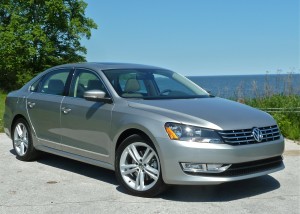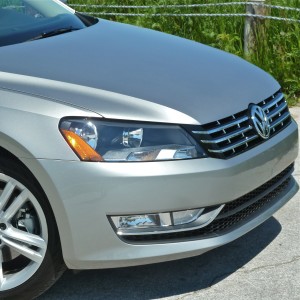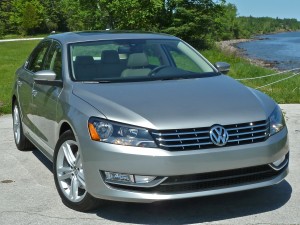Passat TDI Top-Rated for MPG, Power
By John Gilbert
There might be a more comfortably spacious method of getting exceptional fuel economy than the new Volkswagen Passat TDI, but offhand I can’t think of any. A few small hybrid compacts and subcompacts might get similar gas-mileage figures, but the Passat is a roomy and luxurious sedan that ranks with the best full-size cars for comfort and performance, with the TDI model sending it off the scale for fuel efficiency.
The Passat can be selected with a 5-cylinder or V6 gas engines, but the TDI designates the redoubtable 2.0-liter, 4-cylinder Volkswagen turbo-diesel, which has impressive thrust from its powerful dosage of torque, and it just happens to cruise right about at the peak of that considerable power range.
That makes it difficult to avoid stabbing the gas pedal for bursts of available torque for passing and lane-changing, but if you can restrain your foot, you can get astronomical fuel economy figures — well beyond the EPA estimate of 40 miles per gallon highway.
Passat models run from the low $20,000 range up to mid-$30,000s, and the turbo-diesel stands alone, available in two different models. The more basic SE model TDI Passat starts at $26,295, while the fully-trimmed SEL starts at $33,895, loaded as my test-car was.
The new Passat, styled specifically for American buyers, is built in the new Volkswagen plant in Chattanooga, Tennessee, which is just as new as the redesigned sedan.
We had an interesting discussion going about cars on a radio talk-show I conduct in Duluth, Minnesota (KDAL am610). It’s always fun to leave politics, terrorism, and even sports to frequently focus on cars, and as I was discussing selected new cars that reach and surpass 40 miles per gallon, a thoughtful and articulate caller made an interesting comment: “Why aren’t modern cars any better than they were in the 1960s, when a lot of cars could get over 40 miles per gallon?” he said.
I interrupted the man to say: “Name four.”
“Well, more than 40 years ago I had a couple of cars that could get over 40,” he said. “One was a Volkswagen Rabbit that would get 50 or 55 mpg, and another was a Volkswagen Dasher, that also got over 40…”
I interrupted to ask: “I’ll bet those were turbo-diesels, right?”
He answered that they were, and I pointed out that those early VW turbo-diesels weren’t exactly the norm for car engines, but their high mileage included steady puffs of noxious smoke and foul-smelling exhaust, just like other diesels of that era. There also were no emission-controls on those cars, either. While they and a few other gas-powered cars, including the Mitsubishi Mirage (Dodge Colt), and early Honda Civics, could get lofty fuel economy figures, they were offset by the majority of mainstream cars with mileage in the low-teens for mpg, and high-performing cars got gas mileage in single digits.
Facing emission control laws and weight-adding safety regulations, automotive safety and technology have risen to unprecedented levels. The miles per gallon of all cars and trucks have inched upward, but the caller’s curiosity was well-founded, because except for hybrids, it seems that fuel economy has been slow to push those heavier and safer EPA-regulated vehicles to 30 mpg. Hybrids can reach 40 or 50, and so can certain other gas-engined vehicles.
Then there’s Volkswagen with its amazing turbo-diesel development.
European companies and consumers always have known the wonders of compression-powered diesels, but they avoided the U.S. problem of smoky and oily residue. Diesel fuel always has been regulated to be much cleaner in Europe, with sulfur limited to 12 parts per million, for example, while U.S. diesel fuel was allowed at something like 400-plus ppm. When the U.S. finally lowered its diesel regs to 15 ppm. of sulfur, the smoke and fumes vanished. It should be noted that at the same time, European diesel regulations were further lowered from 12 to 8 ppm.
The fuel clean-up allowed the current generation of turbo-diesels to enter the U.S., and all are mandated to burn clean diesel fuel. More are on the way, most notably from Mazda, to join the parade of German cars from VW, Audi, Mercedes and BMW, and General Motors and Chrysler are about to unveil some small and efficient turbo-diesels. It represents a huge attitude change in the U.S., which follows the logical switch in our driving habits.
Back in the 1960s, young guys used to brag about impromptu drag races, blasting off side-by-side to see who could be all-out fastest from stoplights — a pastime that ignited the packaged and promoted sport of drag-racing, a multi-million-dollar sports attraction at quarter-mile strips all around the United States.
Fifty years later, we might still be impressed, if not consumed, with bursts of neck-snapping acceleration, but when folks congregate around contemporary water-coolers at work, they’re more likely to be boasting about their fuel economy or how far they were able to go on a tank of fuel.
Between the time I got the first of two Passat TDI models to test-drive, I happened to talk to my friend, Wayne Gerdes, a journalist who is an outstanding “hyper-miler,” who works out special arrangements to conduct long-term mileage tests with selected cars. He had just completed a test with a Volkswagen Passat TDI in which he drove with a certified assistant making sure his drive touched all 48 contiguous states in an attempt to attain high mileage figures. He has some tricks, to be sure, but mainly it’s just logical, such as no jack-rabbit starts, short-shifting a stick shift car to get into as high a gear as possible as soon as possible, a willingness to average below the speed limit speeds, and a theory of not using cruise-control while letting the car’s speed dip a bit when climbing any hills and catching up on the down-side.
He made it to all 48 states, and it took him seven tankfuls of diesel fuel — an incredible average of over 78 miles per gallon. That even impressed Gerdes, whose usual figures in all cars seem close to unattainable.
Armed with that knowledge, I enjoyed my week with the Passat TDI, although I didn’t come close to my friend’s hyper-mile tricks. I did take it easy, only a couple of times hitting the gas hard enough to plunge forward, with sports-car zest. The Passat’s 2.0-liter 4-cylinder turbo-diesel has 140 horsepower, which isn’t a lot. But it also has 236 foot-pounds of torque, which is more than a lot of larger 6-cylinder engines and even some V8s. Remember, it is torque that provides the thrust for acceleration or pulling, and it’s horsepower that keeps the power getting to the road at cruising speed.
I had driven an SE model with the TDI, and this time I had the fancier SEL Premium model, with leather seats and trim, and a navigation system, along with the 6-speed dual-clutch transmission — an automatic if you count all vehicles without a clutch pedal as automatic, but with two clutches inside the automatic gearbox, both engaging and alternating gears, you get seamless, smooth shifts.
After driving in mostly urban settings, I took the Passat TDI SEL Premium — which has too many names in its name, by the way — on the 180-mile trip. At the end of the drive, as I pulled off the freeway, I clicked the computer over, having reset it for the trip, and it registered 48.1 miles per gallon. On the return trip, it showed 44.5, a figure that actually disappointed me after the spectacular first trip.
I also had time to note some other computer readouts. I zeroed the computer again, at a point when I was cruising on a freeway at exactly 70 mph. After 20 miles it showed 50.0 miles per gallon. I also checked the tachometer, and at 70 mph the rugged little diesel was only turning 1,800 RPMs. I manually downshifted to fifth, and it registered 2,200 RPMs at 70 — still very low, but 70 at a mere 1,800 revs is stunning.
The 2.0-liter 4-cylinder’s 140 horsepower reaches a peak that figure at 4,000 RPMs, but the 236 foot-pounds of torque peak at 1,750 RPMs — right where the needle rests when you’re cruising at 70.
For comparison purposes, the Passat is considered a midsize car, in there with the Honda Accord, Ford Fusion, Chevrolet Malibu, Hyundai Sonata, Kia Optima, Mazda6, Toyota Camry and Nissan Altima, among others. But it feels roomy enough to compete with the larger full-size cars, at 191.6 inches long with a wheelbase of 110.4 inches. It’s 72.2 inches wide and 58.5 inches high, with a curb weight of just over 3,000 pounds, or 3,494 for the luxurious SEL model with the TDI engine.
Interior room measures 102 cubic feet, with 15.9 cubic feet of trunk space. Rear legroom is 39.1 inches and rear headroom 37.8, and at 57.0, the rear shoulder room is slightly larger than in front.
There are a few odd packages for the Passat. The 6-speed manual transmission is only available in the TDI SE, for example, but to get a TDI model with the sunroof requires moving up to the SEL, in which case you only get the automatic. The auto, of course, is the 6-speed dual-clutch unit that, with sport mode, runs the Passat TDI up through its full paces more efficiently than a human can do with the stick.
At that, the DSG can easily reach 50 mpg with moderation from the driver, while the stick version — at least in the hands of a hyper-miler — can get up over 75 mpg with a little expert training. And both have enough room to haul a full adult team’s baseball gear in the trunk, and carry the whole infield in the interior.
Comments
Tell me what you're thinking...
and oh, if you want a pic to show with your comment, go get a gravatar!






 John Gilbert is a lifetime Minnesotan and career journalist, specializing in cars and sports during and since spending 30 years at the Minneapolis Tribune, now the Star Tribune. More recently, he has continued translating the high-tech world of autos and sharing his passionate insights as a freelance writer/photographer/broadcaster. A member of the prestigious North American Car and Truck of the Year jury since 1993. John can be heard Monday-Friday from 9-11am on 610 KDAL(www.kdal610.com) on the "John Gilbert Show," and writes a column in the Duluth Reader.
John Gilbert is a lifetime Minnesotan and career journalist, specializing in cars and sports during and since spending 30 years at the Minneapolis Tribune, now the Star Tribune. More recently, he has continued translating the high-tech world of autos and sharing his passionate insights as a freelance writer/photographer/broadcaster. A member of the prestigious North American Car and Truck of the Year jury since 1993. John can be heard Monday-Friday from 9-11am on 610 KDAL(www.kdal610.com) on the "John Gilbert Show," and writes a column in the Duluth Reader.